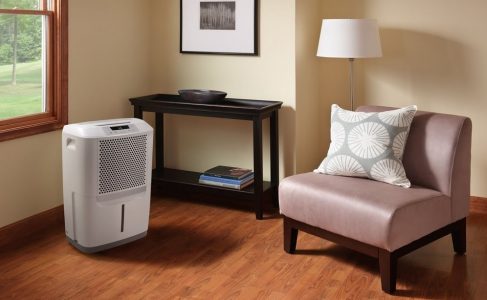My family recently bought our first home dehumidifier. I’ve wanted one for years to help our aging air conditioner with keeping the humidity low and and our comfort high. Read on to see how a home dehumidifier can help keep you comfortable and how it works.
As you may remember from a past article, humidity is an important factor in the comfort level (and health) of a home. In a residential air conditioning system, the thermostat only reads the dry bulb temperature and cycles the unit on or off to meet the desired setpoint. While running, the unit will dehumidify the air. But what happens on a day that isn’t too warm, but still humid? Take for example a raining day in May that is 80 °F with your air conditioner set to 75 °F. Your air conditioner may run a few times to keep it 75 °F, but it doesn’t care that the humidity in the home is high. This is where a home dehumidifer can be helpful. By setting the dehumidifer to a humidity setpoint (typically 50% relative humidity), it will remove the moisture from the air without considering the temperature. Without the dehumidifer to remove the moisture, you would have to overcool the space by turning down the A/C in order to get your desired humidity level. This potentially saves energy by letting you keep your thermostat set at a higher temperature.
A dehumidifer works just like a miniature air conditioner with the exception that the condenser has the cooled air blown over it. The air enters the dehumidifer and passes over the cold evaporator. This cools the air causing some of the humidity to condense on the evaporator. The water falls into the bucket while the cold dry air then passes on to the hot condenser where it is warmed back up. On large commercial systems, this is called hot gas reheat. It would be great if the air could leave the dehumifier at the same temperature it entered, but due to the laws of thermodynamics it will actually leave a little warmer. On the refrigeration side, the system works just like any other simple air conditioner.
There are a few other dehumidification technologies that are very interesting, but have yet to find a major foothold in the market. Desiccant dehumidifiers use humidity absorbing materials which must be re-charged or replaced when full of water. Silica packets in boxes are an example of a (very small) desiccant dehumidifer. Liquid desiccants (sounds like an oxymoron, doesn’t it) are usually reserved for large commercial or industrial applications. They work by having a solution of water and salt (various chemicals and combinations of salts are used). When the concentration of the salt is high, the solution will actually absorb water from the air. The now less concentrated solution is then exposed to outside air and heat which removes some of the water and get the solution nice and concentrated so that the process can be repeated.
Humidity control in a home or business is very important and there are ways that it can be done without breaking the bank. If you are having humidity issues and would be interesting in saving money on your building by saving energy, consider hiring us to complete a Small Business Energy Audit. We will review your building and provide you with options for saving money. Our goal is to provide an affordable service that a business can use to reduce their energy costs. We are happy to work with you to find a solution that fits your budget. If you own or manage a building and are interested in an audit, please contact us today.




